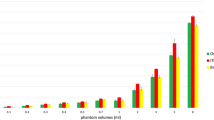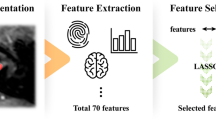Abstract
Purpose
The primary objective was to determine whether the analysis of textural heterogeneity of vestibular schwannomas on MRI at diagnosis was predictive of their radiological evolutivity.
The secondary objective was to determine whether some clinical or radiological factors could also be predictive of growth.
Methods
We conducted a pilot, observational and retrospective study of patients with a vestibular schwannoma, initially monitored, between April 2001 and November 2019 within the Oto-Neurosurgical Institute of Champagne Ardenne, Texture analysis was performed on gadolinium injected T1 and CISS T2 MRI sequences and six parameters were extracted: mean greyscale intensity, standard deviation of the greyscale histogram distribution, entropy, mean positive pixels, skewness and kurtosis, which were analysed by the Lasso method, using statistically penalised Cox models. Extrameatal location, tumour necrosis, perceived hearing loss < 2 years with objectified tone audiometry asymmetry, tinnitus at diagnosis, were investigated by the Log-Rank test to obtain univariate survival analyses.
Results
78 patients were included and divided into 2 groups: group A comprising 39 "stable patients", and B comprising the remaining 39 "progressive patients". Independent analysis of the texture factors did not predict the growth potential of vestibular schwannomas. Among the clinical or radiological signs of interest, hearing loss < 2 years was identified as a prognostic factor for tumour progression with a significant trend (p = 0.05).
Conclusions
This study did not identify an association between texture analysis and vestibular schwannomas growth. Decreased hearing in the 2 years prior to diagnosis appears to predict potential radiological progression.



Similar content being viewed by others
Abbreviations
- VS:
-
Vestibular schwannoma
- CPA:
-
Cerebellopontine angle
- MRI:
-
Magnetic resonance imaging
- ROI:
-
Region of interest
- ICC:
-
Interclass correlation coefficient
References
Macielak RJ, Patel NS, Lees KA, Lohse CM, Marinelli JP, Link MJ et al (2019) Delayed tumor growth in vestibular schwannoma: an argument for lifelong surveillance. Otol Neurotol 40(9):1224–1229
Stangerup SE, Caye-Thomasen P, Tos M, Thomsen J (2006) The natural history of vestibular schwannoma. Otol Neurotol 27(4):547–552
Paldor I, Chen AS, Kaye AH (2016) Growth rate of vestibular schwannoma. J Clin Neurosci 32:1–8
Wu H, Zhang L, Han D, Mao Y, Yang J, Wang Z et al (2016) Summary and consensus in 7th International Conference on acoustic neuroma: an update for the management of sporadic acoustic neuromas. World J Otorhinolaryngol Head Neck Surg. 2(4):234–239
Sethi M, Borsetto D, Cho Y, Gair J, Gamazo N, Jefferies S et al (2019) The conditional probability of vestibular schwannoma growth at different time points after initial stability on an observational protocol. Otol Neurotol 1:250–257
D’Haese S, Parmentier H, Keppler H, Van Vooren S, Van Driessche V, Bauters W et al (2019) Vestibular schwannoma: natural growth and possible predictive factors. Acta Otolaryngol (Stockh) 139(9):753–758
Herwadker A, Vokurka EA, Evans DGR, Ramsden RT, Jackson A (2005) Size and growth rate of sporadic vestibular schwannoma: predictive value of information available at presentation. Otol Neurotol 26(1):86–92
Shin JL, Asa SL, Woodhouse LJ, Smyth HS, Ezzat S (1999) Cystic lesions of the pituitary: clinicopathological features distinguishing craniopharyngioma, Rathke’s Cleft Cyst, and Arachnoid Cyst. J Clin Endocrinol Metab 84(11):3972–3982
Park H, Qin L, Guerra P, Bay CP, Shinagare AB (2021) Decoding incidental ovarian lesions: use of texture analysis and machine learning for characterization and detection of malignancy. Abdom Radiol 46(6):2376–2383
Sandrasegaran K, Lin Y, Asare-Sawiri M, Taiyini T, Tann M (2019) CT texture analysis of pancreatic cancer. Eur Radiol 29(3):1067–1073
Alessandrino F, Gujrathi R, Nassar AH, Alzaghal A, Ravi A, McGregor B et al (2020) Predictive role of computed tomography texture analysis in patients with metastatic urothelial cancer treated with programmed death-1 and programmed death-ligand 1 inhibitors. Eur Urol Oncol 3(5):680–686
Jian C, Guorong W, Zhiwei W, Zhengyu J (2020) CT texture analysis: a potential biomarker for evaluating KRAS mutational status in colorectal cancer. Chin Med Sci J 35(4):306
Davnall F, Yip CSP, Ljungqvist G, Selmi M, Ng F, Sanghera B et al (2012) Assessment of tumor heterogeneity: an emerging imaging tool for clinical practice? Insights Imaging 3(6):573–589
Ganeshan B, Miles KA (2013) Quantifying tumour heterogeneity with CT. Cancer Imaging 13(1):140–149
Miles KA, Ganeshan B, Hayball MP (2013) CT texture analysis using the filtration-histogram method: what do the measurements mean? Cancer Imaging 13(3):400–406
Kanzaki J, Tos M, Sanna M, Moffat DA, Monsell EM, Berliner KI (2003) New and modified reporting systems from the consensus meeting on systems for reporting results in vestibular schwannoma. Otol Neurotol 24:642–648
Tolisano AM, Wick CC, Hunter JB (2019) Comparing linear and volumetric vestibular schwannoma measurements between T1 and T2 magnetic resonance imaging sequences. Otol Neurotol 40(5S):S67-71
Eisenhauer EA, Therasse P, Bogaerts J, Schwartz LH, Sargent D, Ford R et al (2009) New response evaluation criteria in solid tumours: revised RECIST guideline (version 1.1). Eur J Cancer 45(2):228–247
Shrout PE, Fleiss JL (1979) Intraclass correlations: uses in assessing rater reliability. Psychol Bull 86:420–428
Lubner MG, Smith AD, Sandrasegaran K, Sahani DV, Pickhardt PJ (2017) CT texture analysis: definitions, applications, biologic correlates, and challenges. Radiographics 37(5):1483–1503
Fieux M, Pouzet C, Bonjour M, Zaouche S, Jouanneau E, Tringali S (2020) MRI monitoring of small and medium-sized vestibular schwannomas: predictors of growth. Acta Otolaryngol (Stockh) 140(5):361–365
Hajioff D, Raut VV, Walsh RM, Bath AP, Bance ML, Guha A et al (2008) Conservative management of vestibular schwannomas: third review of a 10-year prospective study. Clin Otolaryngol 33(3):255–259
Putz F, Müller J, Wimmer C, Goerig N, Knippen S, Iro H et al (2017) Stereotactic radiotherapy of vestibular schwannoma: Hearing preservation, vestibular function, and local control following primary and salvage radiotherapy. Strahlenther Onkol 193(3):200–212
Deberge S, Meyer A, Le Pabic E, Peigne L, Morandi X, Godey B (2018) Quality of life in the management of small vestibular schwannomas: observation, radiotherapy and microsurgery. Clin Otolaryngol 43(6):1478–1486
Halliday J, Rutherford SA, McCabe MG, Evans DG (2018) An update on the diagnosis and treatment of vestibular schwannoma. Expert Rev Neurother 18(1):29–39
Yomo S, Carron R, Thomassin J-M, Roche P-H, Régis J (2012) Longitudinal analysis of hearing before and after radiosurgery for vestibular schwannoma: clinical article. J Neurosurg 117(5):877–885
Coughlin AR, Hunt AA, Gubbels SP (2019) Is hearing preserved following radiotherapy for vestibular schwannoma? Laryngoscope 129(4):775–776
Speckter H, Santana J, Bido J, Hernandez G, Rivera D, Suazo L et al (2019) Texture analysis of standard magnetic resonance images to predict response to gamma knife radiosurgery in vestibular schwannomas. World Neurosurg déc 132:e228–e234
Langenhuizen PPJH, Sebregts SHP, Zinger S, Leenstra S, Verheul JB, With PHN (2020) Prediction of transient tumor enlargement using MRI tumor texture after radiosurgery on vestibular schwannoma. Med Phys 47(4):1692–1701
Malone J, Tiberi D, Sinclair J, Gaviolli E, Malone S (2020) Delayed pseudoprogression of a vestibular schwannoma postradiosurgery. Radiol Case Rep juin 15(6):749–752
Yang H-C, Wu C-C, Lee C-C, Huang H-E, Lee W-K, Chung W-Y et al (2021) Prediction of pseudoprogression and long-term outcome of vestibular schwannoma after Gamma Knife radiosurgery based on preradiosurgical MR radiomics. Radiother Oncol 155:123–130
George-Jones NA, Wang K, Wang J, Hunter JB (2021) Prediction of vestibular schwannoma enlargement after radiosurgery using tumor shape and MRI texture features. Otol Neurotol 42(3):348–354
Hentschel MA, Hannink G, Steens SCA, Mulder JJS, Rovers MM, Kunst HPM (2021) Development of a model to predict vestibular schwannoma growth: an opportunity to introduce new wait and scan strategies. Clin Otolaryngol 46(1):273–283
Kleijwegt M, Bettink F, Malessy M, Putter H, van der Mey A (2020) Clinical predictors leading to change of initial conservative treatment of 836 vestibular schwannomas. J Neurol Surg Part B Skull Base 81(01):015–021
Funding
No funding was received for conducting this study.
Author information
Authors and Affiliations
Contributions
LUFT: is the first author, designed the study, collected and interpreted the data, drafted the initial manuscript, reviewed and revised the manuscript. JCK: critically reviewed the manuscript for important intellectual content. CD: contributed to designing the study, reviewed and revised the manuscript. EB: critically reviewed the manuscript for important intellectual content. CB: contributed to designing the study, reviewed and revised the manuscript. CH: critically reviewed the manuscript for important intellectual content. AB: critically reviewed the manuscript for important intellectual content. ML: critically reviewed the manuscript for important intellectual content. XD: conceptualized, coordinated and supervised the study, interpreted the data, drafted the initial manuscript, reviewed, and revised the manuscript. All authors approved the final manuscript as submitted and agree to be accountable for all aspects of the work.
Corresponding author
Ethics declarations
Conflict of interest
The authors have no competing interests to declare that are relevant to the content of this article.
Ethics approval
This retrospective chart review study involving human participants was in accordance with the ethical standards of the institutional and national research committee and with the 1964 Helsinki Declaration and its later amendments or comparable ethical standards. The clinical research directorate of our institution (Reims University Hospital) does not require institutional review board or ethics committee review for this type of study.
Consent
All participants were informed of the possibility of using their information for biomedical research purposes and had the right to refuse or withdraw their consent at any time.
Additional information
Publisher's Note
Springer Nature remains neutral with regard to jurisdictional claims in published maps and institutional affiliations.
Rights and permissions
Springer Nature or its licensor holds exclusive rights to this article under a publishing agreement with the author(s) or other rightsholder(s); author self-archiving of the accepted manuscript version of this article is solely governed by the terms of such publishing agreement and applicable law.
About this article
Cite this article
Truong, LU.F., Kleiber, J.C., Durot, C. et al. The study of predictive factors for the evolution of vestibular schwannomas. Eur Arch Otorhinolaryngol 280, 1661–1670 (2023). https://doi.org/10.1007/s00405-022-07651-w
Received:
Accepted:
Published:
Issue Date:
DOI: https://doi.org/10.1007/s00405-022-07651-w




